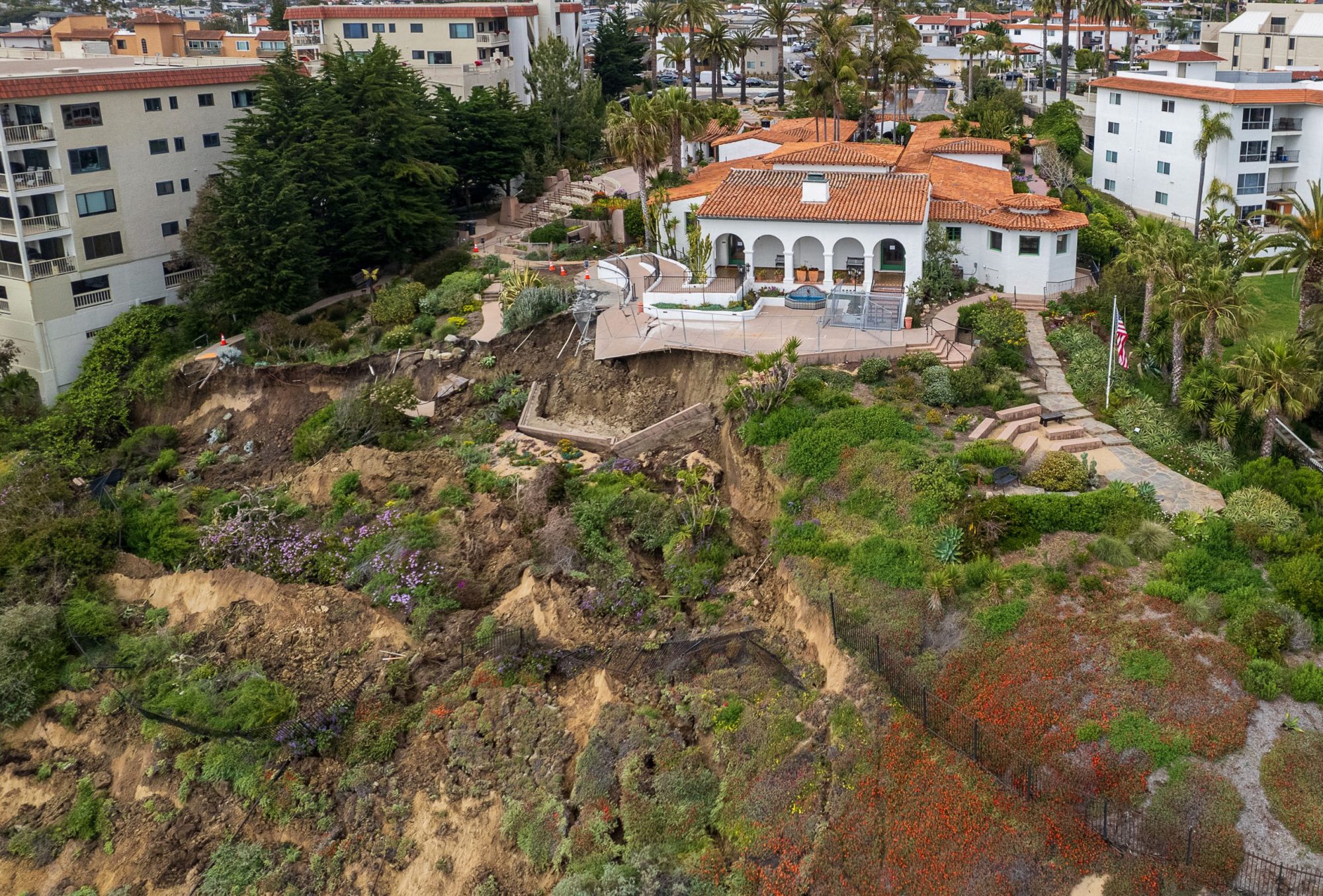
The hillside behind Casa Romantica Cultural Center and Gardens has seen sustained significant movement following Thursday’s major landslide that resulted in the 20-foot collapse of the historic property’s back patio area and landscaping.
San Clemente Mayor Chris Duncan, who joined other elected officials for an informal press conference Saturday afternoon, said he has seen movement roughly 40 feet down the hillside as there appears to be a daily progression.
“Every time we give an assessment of the area, it changes a little bit after that,” he said. “We haven’t gotten to a point of stability or neutrality yet (to) where we can start looking.”
The city has been able to install an inclinometer on the Casa Romantica property—the former home of town founder Ole Hanson—to record baseline measurements on Friday before conducting daily updates moving forward.
Duncan called the situation heartbreaking and tragic.
“You see the amount of earth that has moved down the hillside, (and) your heart just absolutely drops and your eyes well up because this is so important to all of us,” he said.
According to Duncan, the city late Friday night, moved to vacate residents living in one of the neighboring structures, Reef Gate’s Building A, the lowest elevation of the complex’s three buildings.
He added that he hasn’t received any information regarding movement in nearby structures and there aren’t current plans to place yellow tags on such buildings.
The landslide, just above the railroad near the San Clemente Pier station, has also prompted Metrolink and Amtrak to temporarily suspend passenger train services through San Clemente.
According to Metrolink, weekday train services will deliver passengers as far south as the Laguna Niguel/Mission Viejo station, while weekend services will operate as far south as the station in Downtown San Juan Capistrano, until further notice.
Collaboration was the common theme of Saturday’s press conference that included Duncan, Rep. Mike Levin and Fifth District Board Supervisor Katrina Foley. The three had gathered at the Casa’s ground as Duncan showed Levin the damage to the rear hillside.
All three officials stressed the need to work together at the local, state and federal levels to facilitate short- and long-term solutions.
In a special meeting this past Monday, the City Council allocated $75,000 for a preliminary geotechnical evaluation. Duncan, who expressed his gratitude for the presence of larger governmental entities on Saturday, said those coffers can now be used for geological studies to assess the current movement.
“We don’t have (resources) available in San Clemente, so we’re going to lean on our federal, state and county partners,” Duncan said. “We’re going to look to the public, perhaps, to help us out as well.”
Foley on Saturday added the county’s perspective and her knowledge as a member of the Orange County Transportation Authority (OCTA) Board of Directors. The debris and dirt from the landslide, she said, are just part of what contributed to the railroad tracks temporarily closing in the San Clemente area for the third time in two years.
Concerns from San Juan Capistrano businesses poured into Foley’s office, as many were worried about how their businesses would be affected by the commuter trains not operating during the weekdays.
“I don’t see the tracks opening up anytime soon,” said Foley. “(The railroad companies) are working on alternative busing to be able to get people who use the rail system for work, for school, and those kinds of things who don’t have a choice (to their destinations).”
Touching on the county’s emergency declaration following last month’s heavy rainstorms that will expire on May 9, Foley said she’ll work to extend the declaration to include the site’s historical significance and get reimbursements for emergency work.
Such funding doesn’t exist for displaced residents staying in lodging, however.
“Unfortunately, there’s not a lot of support in terms of resources for moving people into local housing,” Foley said. “They kind of push (people) out of the county, and we’ve got to fix that, and that’s something of a priority for me.”
Another point of emphasis for Foley was the need to “commit” to fixing the issue long-term instead of treating coastal erosion and other natural disasters that affect the railroad system with bandages.
Moves such as spending $13 million on stabilizing the railroad at Cotton’s Point and other patchwork solutions are costing all stakeholders more money, according to Foley.
In addition to Levin’s $4 million request from the federal government to aid in OCTA’s multi-phase South County rail study, Foley said her office has also received word of a similar request from Sen. Diane Feinstein and a $5 million commitment from the state rail system.
“In the long term—and the Congressman and I have talked about this a lot—we must work on an overall better rail plan that takes the rail off the coast, because it’s unsustainable on the coast,” said Foley.
Levin echoed her sentiments about needing to relocate the tracks and shore up the rail corridor.
“(The corridor provides), from an economic standpoint, roughly a billion dollars a year in economic impact on our region,” he said. “So, when the rail corridor has shut down, even for a week or a month, we’re talking about tens or even hundreds of millions of dollars in regional economic impact.”
His office will explore all angles to bring federal assistance to Casa Romantica, Levin added.
The city stated in a press release Friday that the California Coastal Commission has contacted its staff as an indication of being willing to provide support.
Additionally, San Clemente and Metrolink have agreed to share data going forward, as the rail entity has its own consultants investigating and surveying the hillside with drones.
